#bullar
Text



Fika
aggiebeaphoto
#fika#cardamom#kardemummabullar#kardemumma#bullar#bun#cardamom bun#cat#ginger cat#orange cat#christmas#cosy#photography#food photography#aggiebeaphoto
3 notes
·
View notes
Text

Checkout our Bullar Gym Equipments for Daily Workout Routine
Start your Body Building Exercises & Workout from now. We offer wide range of Bullar Gym Equipments for daily workout routine at an Affordable Prices.
0 notes
Note
I'll be honest, after having a glimpse of your buns, I am no longer so sure about mine. Honestly, there is no comparison! Yours are in perfect shape, soft, ready to be grabbed and munched on on the go. I— I think my metaphors are getting out of hand. I love pastries. Anyway. Any recommendation on how to make my buns as prominent and springy?
Oh, well, firstly, what truly sets apart a remarkable bun from the rest is the kneading. You must treat your dough with tender care, caressing it with gentle yet firm strokes, moulding it into submission until it yields the desired suppleness and elasticity.
Remember, patience is the secret ingredient here. Allow your dough to rest and rise, giving it ample time to develop those irresistible curves.
If you wish, we can always bake some buns together, or I could guide you through each step. :)
9 notes
·
View notes
Text
“Leila is as good at folding linens and she is at folding fools”
Hot damn!
4 notes
·
View notes
Text
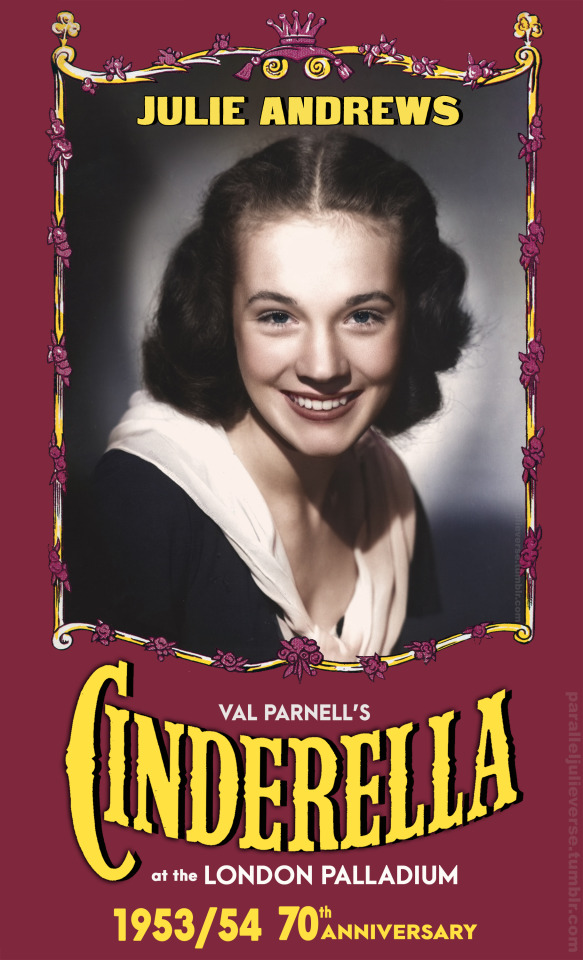
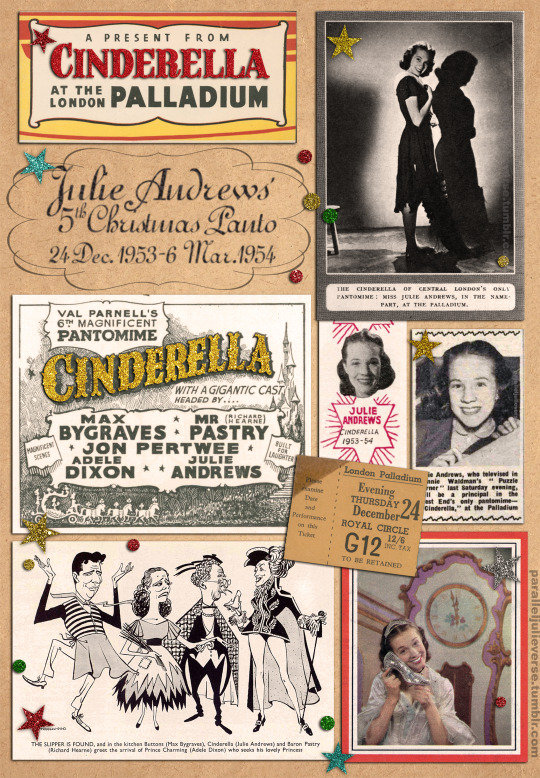
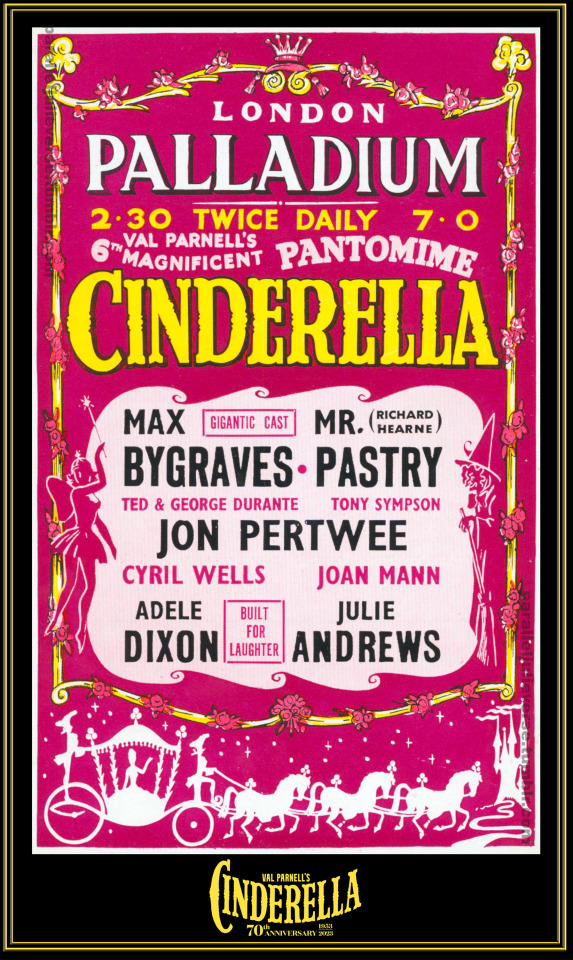

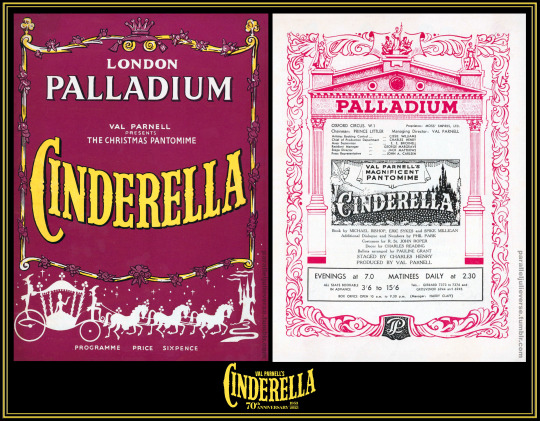

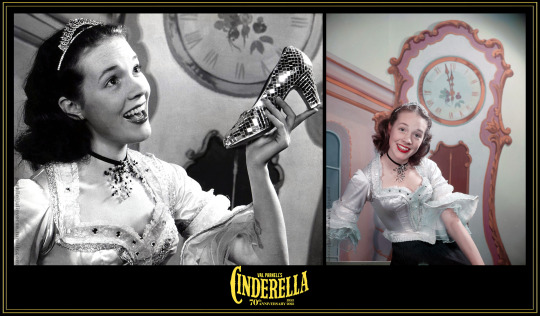

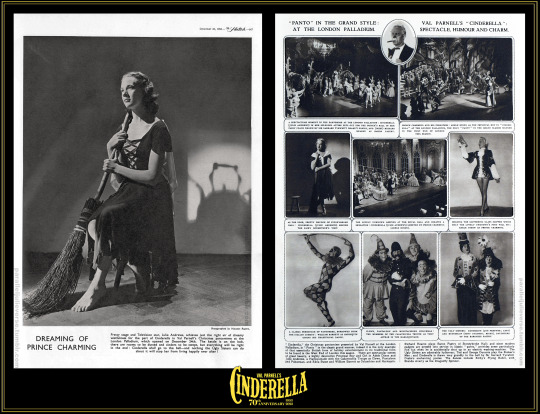




70th anniversary of Cinderella
London Palladium, 122 performances
(24 December 1953 - 6 March 1954)
This month marks the 70th anniversary of a milestone in the early career of Julie Andrews: the opening of Val Parnell's lavish Christmas pantomime, Cinderella, at the London Palladium on 24 December 1953.
Cinderella would be Julie’s fifth and final UK pantomime, following earlier runs in Humpty Dumpty (1948), Red Riding Hood (1950) Aladdin (1951), and Jack and the Beanstalk (1952). It was the biggest theatrical production Julie had yet undertaken and it would prove a turning point in the young star's career.
'No Pigtails for Julie'
By 1953, Julie was turning 18 and fast outgrowing the "infant prodigy" label of her early career. Efforts had been made for some time to update Julie's star image with a more mature look and an expanded musical repertoire. Much was made in the press about the new "[g]rown up now (or almost) Julie Andrews" (Bendle 1953: 2). "The tiny pigtailed schoolgirl who at age 13 sang in a Royal Command Performance," remarked one newspaper commentator, "is now a long-limbed attractive young lady who is wearing her first strapless dresses" (Pearce 1954: 6).
As an archetypal tale of girl-to-woman metamorphosis, Cinderella was an ideal vehicle with which to advance these transformative ambitions. It not only gave Julie titular 'principal girl' status, but called on her to assume a role of emotional nuance and adult sophistication.
Even Julie's mother, Barbara, is reported to have exclaimed:
“Julie, this is the perfect part for you at the perfect age. It couldn’t have come at a better time in your career" (Andrews 2008: 156-57).
Val Parnell presents...
Underscoring the significance of Cinderella was the fact it was a Val Parnell production. Dubbed 'Britain's Mr. Show Business', Parnell was a hugely influential impresario who dominated the British entertainment scene for many decades. He had started in provincial variety management before progressively rising up the ranks to assume control of the prestigious Moss Empires theatre chain (Bullar & Evans 1950: 219). Later, Parnell would go on to play a significant role in the expansion of the British television industry as General Manager of ATV, the first commercial television network in the United Kingdom (Sendall 1982: 250).
Renowned for his astute promotion of new talent, Parnell had been instrumental in launching Julie's career when he cast her in her first professional show at just 12 years of age: the now legendary Starlight Roof at the London Hippodrome in 1947/48 (Alldridge 1954: 1). Cinderella would bring the two together again for the first time in six years. To hear Parnell tell the story, it was a reunion long in the making.
"From the moment [I] first heard her sing," he declared, I "made a mental note that one day [I] was going to present Julie Andrews as Cinderella." As he explained:
"So many child performers are inclined to be precocious...But Julie was not. She had that appealing simplicity which she still retains. It struck me at the time that she had all the qualities of an ideal Cinderella -- youth. freshness, charm" (Lanchbery 1954: 1).
At the London Palladium
Of all the theatres managed by Parnell, none was more celebrated than the London Palladium, a 2200 seat theatre noted for its opulent architecture and state-of-the-art stage facilities (Woodward 2009). Parnell's adept leadership propelled the Palladium to international acclaim as the most famous variety theatre in the world and a top drawcard for international stars. "To appear at the Palladium is the goal to which every artist strives," noted a 1957 newspaper commentary, "to appear at the Palladium is to have achieved star status!" (Hoddinott 1957: 4).
The Palladium was also an important venue for Christmas pantomimes. Under Parnell, the Palladium "became the home of spectacular pantomime" with audiences eagerly anticipating each year's offering (Baker 2014: 219). Parnell applied the same triumphant formula to the humble British panto that he used in his variety revues: a blend of star power, spectacle, and money.
Writing in 1952, Ian Beven chronicled Parnell's studied approach to his annual pantomime at the Palladium:
"Each year...Parnell has tried to produce something bigger and better than the year before...He starts in midsummer, with a bare stage. By the third week in December, he has spent about £25,000 on scenery, costumes, musical arrangements, script, and rehearsals...Running costs of the show are high, as Parnell is prodigal with talent and fills his stage with people, and there are only about 140 performances on which to make a profit; but there is no disguising the fact that pantomime in this manner is a highly remunerative proposition, for there is rarely an empty seat throughout the run" (Seven 1952: 223).
Val Parnell's Magnificent 'Cinderella'
Cinderella would be Parnell's sixth pantomime at the Palladium. It would also be the only fully-staged panto in the West End for the 1953 Christmas season. In a sign of the rapidly changing post-war theatre scene, most of the other major London houses were tied up with long-running musicals and plays, largely imported from America. In addition, arena-style ice spectaculars were increasingly in vogue with a slew of new-fangled pantos "on ice" scheduled for suburban venues, leading some wags to quip that Parnell should call his show "Cinderella on Wood" ('Old fashioned Val' 1953: 6).
While many lamented it as a sign of "the decline and fall of the honoured institution" of the traditional panto, the absence of competition gave Parnell a distinct commercial advantage ('At the Pantomime', 1954: 4). When pre-sales for Cinderella opened in the autumn of 1953, the booking office was inundated and the show would become the theatre's most successful pantomime to date (Alldridge 1954: 4).
It also spoke to Parnell's innate sense of theatrical traditionalism. Though he was certainly not averse to innovation and was quick to adopt state-of-the-art technologies, Parnell was a producer of the old school. He believed in sticking to the tried-and-true and giving audiences what they expected. "Audiences haven't changed at all," he opined, "Certainly not the Palladium audiences. It's the same as it ever was. People go the the theatre to enjoy themselves...My job is to give it to them in bigger and better shows" (Hoddinott, 1957: 4)
True to this crowd-pleasing philosophy, Parnell determined to make Cinderella his most spectacular panto yet. Planning for the show started early in 1953. "I always start pantomime with a bare stage," he declared, "Everything must be new" (Fagence 1958: 4). Heading the production team were two influential figures who were something of righthand men to Parnell: Charles Henry and Charles Reading.
Henry was Chief of Production at the Moss Empire chain for over thirty years. During his tenure, he would produce over 200 revues and pantomimes, as well as fourteen Royal Command Performances (Born & Frame 1960: 4; 'Charles Henry' 1959: 1). Known as a canny talent-spotter with an encyclopaedic memory -- Bud Flanagan famously called him "a blinking card index of comedy" -- Henry was fondly remembered by Parnell at his passing in 1968 as "one of the theatre's greatest backroom boys" and "my closest associate" (Evening Standard Reporter 1968: 17).
Reading was an equally trusted majordomo for Parnell. A true theatre polymath, Reading trained as an actor before expanding into production, direction, writing, and design. It was the latter talent that brought Reading initial fame with a series of innovative opera and ballet designs for Sadler's Wells and the Old Vic. He subsequently moved into designing more commercial fare in the West End and, in 1947, was contracted by Parnell as resident designer and production assistant at the Palladium (Barker 199: 20; Vallance 199: 36).
Together Parnell, Henry, and Reading set about staging Cinderella as an unparalleled spectacular. Set and costume design alone was budgeted at over £20,000, which equates to almost £700,000 in today's money (Webster 2013). Reading designed an intricate series of progressively spectacular sets, including a palatial Ballroom, a Cave of Crystal Lustres, and a Palace of Porcelain for the grand finale (V&A 2015).
Famed stage couturier, Robert St John-Roper, designed a complementary suite of costumes including a dazzling ballgown and bejewelled wedding dress for Julie. In her 2008 memoir, Julie recalled the breathtaking splendour of it all:
"Everything about that 1953/1954 production of Cinderella had a certain elegance...The production values on the show were terrific; there were revolving stages, and real white ponies pulling the spectacularly gilded coach...In the grand finale wedding sequence, my crinoline was so huge that I had to arrive backstage dressed in my bodice, sleeves, and petticoat, and walk into the crinoline skirt, which was braced on a stand because it was so bejewelled and cumbersome. The company, Prince Charming, and I were brought up from below stage on a hydraulic elevator, to be revealed in a sparkling white set and costumes for the final tableau" (Andrews 2008: 155-57).
Spectacle, Humour, and Charm
Careful attention was equally paid to the other production elements of Cinderella to ensure a well-wrought work of quality theatrical entertainment. To write the script, Parnell commissioned a trio of talented young writers who were only then beginning to make a name for themselves but who would go on to become giants of British comedy: Eric Sykes, Spike Milligan, and Mike Bishop. Their original treatment hewed closely to the core elements of the well-known fairy story but embroidered with innovations and, true to panto style, comic flourishes.
In the Sykes et al script, the story opens with Baron Pastry of Stoneybroke Hall lamenting that he has fallen on hard times (Stoneybroke...get it?!). He lives with his beloved daughter, Cinderella, and their faithful but hopeless retainer, Buttons who carries an unrequited flame for Cinderella. The Baron announces he has just married a wealthy widow in the vain hope of restoring his fortune. She comes to the Hall with her two unloved and unlovable daughters -- the Ugly Stepsisters, of course -- and they set about making Cinderella's life a misery. The requisite Royal Ball, benevolent Fairy Godmother, and Glass Slipper hunt all ensue before the inevitable happily-ever-after ending (Sykes et al. 1953).
Woven around these well-worn plot points were a series of comic interludes designed to accomodate the pantomime conventions of audience participation and novelty acts. These ran the gamut from a demonic door and a bomb-toting spaceman ("it's behind you") to jive singing footmen and a giant electric washing machine that tumbled a hapless Baron Pastry along with an assortment of oversized clothes (Sykes et al. 1953).
Song and Dance
No pantomime would be complete without music and dance and Cinderella served both in abundance. Overseeing the musical side of things were another pair of Palladium panto stalwarts: Phil Park and Bobby Howell.
Park had been a star cinema organist during the picture palace era but, following the war, he turned his attention to composing and arranging. It was in this capacity that Park worked frequently for Parnell on his Palladium pantos which he "tailored to the stars appearing in the shows but always preserved the time-honoured tradition" ('Obituary: Phil Park' 1978: 6).
Bobby (aka Bobbie) Howell was a prominent band leader of the inter-war years, touring the cinema and dance circuits. After the Second World War, he became a musical director in the West End, working on a string of successful shows such as Strike a New Note, The Lisbon Story, and Piccadilly Hayride. He also worked as musical director and conductor on many of Parnell's pantomimes, including Cinderella ('Bobby Howell' 1962: 3).
In crafting the musical score for Cinderella, Park and Howell followed typical pantomime form of mixing existing well-known tunes with bespoke compositions. Many of the latter were written by Park including a humorous duet between Cinderella and Buttons (played by Max Bygraves). In this duet, Cinderella fantasises about a romantic future with the Prince, while Buttons humorously interjects with sardonic quips:
Cinders: There's a lady -- and she curtseys,
Who she is, I cannot guess.
She might be me, except that she
Has such a pretty dress.
And there's her handsome partner,
Who is he, do you suppose?
Buttons: All I see's a turkey,
With a whopping parson's nose!
Cinders: Now I see him very clearly,
With a smile upon his face;
I'm certain he's a Prince,
Because he bows with royal grace.
See now he takes her hand,
And lifts it gently to his lips!
Buttons: He looks like George Dawson,
With a plate of fish and chips!
In addition to the duets, Julie had two showcase solos in Cinderella: "Chasing Shadows", a 1935 torch song by Silver and Davis, and "Is it Any Wonder," a lilting pop ballad by Bob Hayes and Roy Rodde which had been a recent chart hit for Joni James.
Interestingly, both solos were modern pop standards and, thus, a marked departure from the light classical repertoire that had been Julie's stock-in-trade. She did get to do some limited coloratura trilling in the extended Transformation Scene at the climax of Act 1 where Strauss waltzes formed the musical accompaniment, but the strong emphasis on popular tunes was indicative of the strategic shift in Julie's image mentioned earlier.
A number of reviewers remarked that Julie didn't seem to do as much singing in Cinderella as they were expecting. She did, however, compensate with quite a bit of dancing -- more dancing in fact than she'd ever done in a professional context.
Not only was there the mandatory waltz with the Prince, but Julie had a solo dance early in Act 1. She was also a key part of the pre-intermission ballet sequence. Choreography for Cinderella was provided by Pauline Grant with whom Julie had worked so happily the previous year in Jack and the Beanstalk. Pre-show publicity photos showcased Julie's dance rehearsals with Grant, underscoring her now mature lithe figure and womanly style.
A Who’s Who of Cinderella
Alongside Julie, the cast of Cinderella was a roster of star names and variety notables:
Max Bygraves as Buttons: Born in 1922 in London, Bygraves was a versatile entertainer known for his Cockney persona, humorous storytelling, and sentimental singing. His endearing catchphrases and relaxed chummy style made him a beloved figure in British entertainment. Growing up in a modest family, he showed early signs of showmanship, encouraged by his prizefighter father. Bygraves left school at 14 and served in the RAF during WWII, where he began entertaining troops. His career took off post-war with various stage and radio appearances, including Educating Archie where he first performed alongside Julie. He made several films in the 1950s and his recordings, often nostalgic or comedic, were hugely popular. He continued performing internationally for many years, eventually settling in Australia. Recognised for his contribution to entertainment, he was awarded an OBE in 1982. He passed away in 2012 (Leigh 2012: 37).
Richard Hearne as Baron Pastry: Born in Norwich in 1909, Hearne came from a family with deep roots in music hall and circus arts, and he started performing on stage as a child. Hearne's career in variety and revue culminated in the creation of the beloved Mr. Pastry, a bowler-hatted, walrus-moustached character that brought him success in West End shows, pantomime, and TV, both in the UK and internationally. His role in Cinderella was effectively an adaptation of Mr Pastry complete with his signature comic dance, "The Lancers". A dedicated philanthropist, Hearne was a very active supporter of handicapped children and was honoured with an OBE in 1970 for his charity work. He passed away in 1979 ('Obituary: Richard Hearne', 1979: 27).
Adele Dixon as Prince Charming: Born in South London in 1908, Adele Dixon was a versatile performer known for her roles in London and Broadway musicals, Palladium pantomimes, and Shakespearean plays. After training at the Italia Conti Academy and the Royal Academy of Dramatic Art, she joined the Old Vic company. There, she shone in roles like Juliet and Ophelia. Dixon's transition to musical comedy in the 1930s made her a celebrated figure in the West End, admired for her red-gold hair, expressive brown eyes, and clear soprano voice. Her noteworthy performances included leading roles in Lucky Break, Anything Goes, and Over She Goes. Additionally, she appeared in the film Calling the Tune and became the first female performer on BBC Television in 1936. Dixon continued her success in post-war years with major hits like The Fleet's Lit Up and All Clear. She was also highly acclaimed as a Principal Boy in pantomimes, performing in these trouser roles 14 times throughout her career. Her portrayal of Prince Charming in the 1953 production of Cinderella marked her last appearance on the West End stage. While she continued to perform in provincial roles, health issues forced her into early retirement in the late 1950s. Dixon passed away in 1992 (Thornton, 1992: 29).
Joan Mann as Dandini: Welsh-born Mann trained as a dancer and started touring the variety circuit in her teens where she appeared on bills with stars including Max Miller and Tommy Trinder. A tall attractive brunette with a pleasant voice and shapely dancer’s legs, Mann was a perfect pantomime boy. She played opposite Julie in Jack and the Beanstalk (1952) and also toured with her as part of the musical revue, ‘Cap and Belles’ in 1953 (Andrews 2008: 146). Though she wasn't Principal Boy in Cinderella, Mann played the other leading pants role of Dandini, the Prince's Squire. Mann’s greatest fame came later as part of the celebrated Fols-de-Rols variety troupe with whom she performed for almost two decades. She also starred opposite Dame Anna Neagle in the hit West End musical, Charlie Girl in the late-1960s. Mann died in 2007 aged 87 (P.N., 2007: 53).
Jon Pertwee as Buttercup: Born in 1919, Pertwee was a versatile actor who left a significant mark in television, radio, theatre, and film. Educated at Sherborne, he belonged to a family of distinguished artists and made his acting debut in 1939 in Brighton. His notable wartime service on the HMS Hood led to a fruitful collaboration with Eric Barker in comedy writing and radio. Pertwee became a household name with his long-running role in the BBC radio series, The Navy Lark. He gained even greater international fame on television as the third Doctor Who from 1970 to 1975, and as Worzel Gummidge. Pertwee's career spanned over 100 films, including two Carry On movies, and numerous stage productions. In Cinderella, Pertwee took on the comic drag role of Buttercup, one of the Ugly Sisters. Pertwee passed away in 1996, leaving a legacy as a unique and memorable actor (Newley, 1996: 38).
Tony Sympson as Dandelion: Born in East London in 1907, Tony Sympson had a dynamic career in music and theatre. Initially trained as a choral scholar at St Clement Danes Church Strand, he made his stage debut as a specialty dancer in Dear Love. A mainstay character actor in West End theatre, he appeared in plays, musicals, revues, pantomimes, and operas. Sympson also featured in television ads where he earned a reputation for well-conceived characterisations. A pantomime regular, Sympson played the second of the Ugly Sisters, Dandelion, in Cinderella, a role he would repeat in subsequent productions. Sympson died in 1983 at the age of seventy-six (Marriott, 1983: 7).
Cyril Wells as Baroness Pastry: Born in Belfast in 1907, Wells' entry into acting was fortuitous. Initially a bank clerk, his passion for dancing led him to become a rehearsal partner for actress Jessie Matthews. This collaboration resulted in Wells being cast as her dance partner in the 1936 film It's Love Again, his only appearance on screen but a stepping stone into show business. He then featured in West End musical comedies like Order to View (1938), Here's Looking at Them (1939), and The Charcoal-Burner's Son (1939). Post-war, Wells shifted to comic roles in theatre and variety, notably in pantomime. In Cinderella, he played the Dame role of the blue-wigged Baroness. Wells passed away in 1958 in Southport, Lancashire ('Obituary: Cyril Wells', 1958: 9).
Ted and George Durante as the Broker's Men: One of several novelty acts to appear in Cinderella, the Durantes were a popular acrobat comic duo who found popularity on the post-war variety circuit. Contrary to their billing as brothers, the duo actually comprised two unrelated individuals, Ted Aston and George Mooney. They met in 1946 while performing as part of an acrobatic troupe and decided to branch out as partners, adopting the Durante surname at random. Their act ran for nine years till the late-1950s when Ted married and formed a new double act with his wife, becoming 'Ted and Hilda Durante'. This husband-and-wife team continued for many decades, becaming regulars on TV variety shows in the sixties and seventies (Wilmut, 1985: 182).
Elaine Garreau as the Godmother: Anglo-French actor Garreau, born in 1903, had an extensive and diverse career in British theatre, film, and television. She trained as a dancer, starting on the London stage at age 11 with a company of child artists. At 16, she was principal dancer at the Théâtre des Ambassadeurs in Paris and, at 20, understudy to the legendary Mistinguett. Returning to the UK, Garreau transitioned to acting and performed for many years in various London and provincial troupes across drama, comedy and musicals. Throughout the 40s and 50s, Garreau appeared frequently in pantomimes. In Cinderella, she took on the role of the magical Fairy Godmother. A few years later in 1958, Garreau would play again opposite Julie as part of the original London production of My Fair Lady, in the role of Lady Boxington. Garreau would remain with the show for over 10 years in both the Drury Lane and touring productions, racking up over 3,000 performances which was a world record. In her later career, Garreau increasingly appeared as a character actor in film and television. Garreau died in 2000 at the grand age of 97.
Silvia Ashmole as the Fairy Queen: Born in 1926, Ashmole enjoyed an idyllic childhood, travelling through Europe with her affluent parents and attending Cheltenham Ladies College. A trip with her mother to the ballet in London inspired Ashmole to take dancing lessons and, at age 16, she enrolled in the Cone-Ripman School of Dance, where she quickly excelled. Soon thereafter she secured a place in the coveted Royal Ballet (Sadler's Wells) and toured with them for several years. During a season at Glyndebourne, she met and eventually married the renowned Anglo-German opera director Peter Ebert. Ashmole continued her career as a dancer, often performing in operas at Glyndebourne and Edinburgh. She also worked frequently with choreographer Pauline Grant who contracted her to appear as the Fairy Queen in Cinderella (Wigglesworth 2018).
The Casavecchia Troupe as the Clowns: Billed as the "World's Greatest Comedy Tumblers," the Casavecchia Troupe was a team of acrobats who had worked individually in circus and variety before combining their talents. They toured widely in the UK variety circuit during the late-40s and early-50s. In Cinderella, they appeared as part of the Harlequinade sequence where their slapstick routine offered well-received comic relief.
William Barrett and Edna Busse as Harlequin and Columbine: Barrett and Busse were a pair of classically trained ballet dancers who danced the classic roles of Harlequin and Columbine in the Act 1 Harlequinade. Barrett was born in 1919 in Staffordshire and joined the Sadler's Wells Ballet company in the late-40s, touring with them to the US ('From Farm' 1954: 11). In the 60s and 70s, he performed in theatre and TV as a resident member of the Black and White Minstrel Show. He later retrained as a drama teacher and passed in 1995 (Jevons 1995: 29). Edna Busse was born in Melbourne in 1918. A protégé of Edouard Borovansky, she later honed her skills in London with Mathilde Kschessinska. Returning to Australia, she continued to perform, before transitioning into a revered ballet teacher. She passed in 2019, aged 100 (Yeo 2019).
The Aida Foster Babes: One of many companies of dancing juveniles popular in the era, the Aida Foster Babes were students of the Aida Foster Academy in Golders Green, London. Established in 1929, the Academy trained several generations of young hopefuls till ists closure in 1970, including several famous alumni such as Jean Simmons and Barbara Windsor ('End' 1970: 43). For Cinderella, Foster provided a group of 12 ‘babes’ who performed in several of the show’s lavish dance sequences.
Critical and Popular Reception
Cinderella was very well received by audiences and critics alike. The following excerpts give a sense of the uniformly glowing notices earned by the show, with particular mention of Julie:
Daily News: "Mr. Val Parnell has really done us proud. There can hardly be two more endearing comics than Max Bygraves and Richard Hearne. Julie Andrews, less operatic than I would have expected, is just the girl for Cinders, and she dances gracefully...a most spiffing pantomime" (E.F. 1953: 4).
The Tatler: "Cinderella has taste, beauty and elegance...But if there is more spectacle than of other good things who will complain, since the result...is so giddily splendiferous. The lighting and the costumes and the scenery could not better done...The principals are worthy of their splendiferous surroundings. Miss Adele Dixon has the right princely strut and Miss Julie Andrews, though she is less vocal than she was expected to be, makes Cinderella a young lady of character and charm" (Cookman 1954: 10).
Daily Mail: "Star names may shine all over the programme -- Max Bygraves and Richard Hearne here; Adele Dixon and Julie Andrews there -- but spectacle is the real star of Val Parnell's typically sumptuous pantomime. Instead of scuffling through the usual sleight-of-stagehand transformation scene Cinderella escapes from the kitchen by way of magic force, fairy spinning wheel, and luminous flying ballet to the cave of crystal lustres: a silvery-white vision as glittering as a wedding cake brush to life" (Wilson 1953: 4).
The Guardian: "Pantomime, though represented only by a single Cinderella in Central London, still flourishes...Cinders (Julie Andrews) croons before the dying kitchen fire...Max Bygraves and Richard Hearne use routine 'biz' to good effect...But what is really remarkable and characteristic of Pantomime 1953 is the standard of the ballet: the scene before Cinders goes off in her glittering coach is as smart, fast, extravagant and excitingly danced as a finale at the Moscow Opera" (F.B. 1953: 3).
The Observer: "The new Palladium Cinderella is magnificent to the eve and its Transformation Scene has fine taste as well as sumptuosity...Julie Andrews is a most attractive Cinderella but not so vocal as I expected" (Brown 1953: 6).
Daily Telegraph: "Cinderella...is up to the best Palladium standard. Elaborate spectacle and attractive dancing combine to delight one's eye. Adele Dixon is an admirable Prince Charming -- she has always been able to fill a big stage with her personality -- and Julie Andrews, kept oddly short of chances to sing, makes Cinderella a young lady of character and charm" (Darlington 1953: 7).
The People: "This is a grand and glamorous show with Julie Andrews as Cinderella. But it would have been grander still had they let her sing more. Adele Dixon constantly charms as the Prince. Max Bygraves and Richard Hearne provide a crescendo of laughs" (Shepherd 1953: 5).
The Times: "It is a hard fact for traditionalists to swallow that there is only one pantomime on the grand scale in the West End...yet if the dismayed traditionalists go the Palladium..., they will soon be cheered up....Here, it seems to say with complete confidence, is one of the few things in a changing world that have remained constant...The humour...is received with every sign of enjoyment and the romantic side of the show is from the first in good trim...Miss Adele Dixon and Miss Julie Andrews belong to the order of unobtrusively pleasant principles. They are an appealing pair, and they have in Mr. Max Bygraves an affable Buttons" ('The Palladium' 1953: 8).
The Stage: "Mr. Parnell has thrown everything into a demonstration of faith, assembling a director's dream of a cast and applying it to all the skill, experience and efficiency that have set the Palladium high in the world of entertainment. He lavishes talent and creative art, he employs every device of lighting, mechanical contrivance and novel effect that the theatre possesses, underlines it all with a defiant and traditional Harlequinade, and the result is the pantomime of pantomimes...Julie Andrews's fragile charm graces Cinderella's rags and raiments alike, and Adele Dixon's slim figure and are of intelligent humour are a delight" ('Christmas Shows' 1953: 5).
The Sketch: "It is the happiest panto-subject, and this is as happy a version as I remember. Richard Hearne in the bowels of a washing-machine, Adele Dixon and Julie Andrews to end rightly as Prince and Princess, Max Bygraves to chant 'Bighead!' -- here they all are, and Val Parnell has never had a spectacle more satisfying than the magical creation of coach and gown." (Trewin 1954: 18).
A Real-Life Cinderella
In many ways, Cinderella signalled something of a pinnacle for Julie's early British career. She was now a young woman in a starring role on the West End stage and, in professional terms, could scarcely go much further. Julie herself writes that "I felt that with Cinderella, my career had peaked" and whatever future she may have would be a continued cycle of "radio, vaudeville and pantomime" (Andrews 2008: 157).
But the theatre gods had other plans and a real-life Fairy Godmother materialised to change the course of Julie's life forever. Midway through the run of Cinderella, Julie was paid a backstage visit by Vida Hope, the producer of the smash hit London musical, The Boy Friend. There were plans to take the show to New York with a new company, but the producers were struggling to cast the lead role of Polly Browne. At the suggestion of Hattie Jacques, Julie's former co-star in Educating Archie, Hope went to see Julie in Cinderella and offered her the role.
It is part of theatrical lore that Julie was initially reluctant to accept the offer, but she was eventually persuaded to seize the opportunity (Andrews 2008: 157-58). Five months after the close of Cinderella, Julie flew off to New York and the rest, as they say, is history...
References:
Alldridge, John (1954). 'Oh, for another Gracie! says Mr Show Business.' Manchester Evening News. 12 October 1954: 1.
Andrews, Julie (2008). Home: A memoir of my early years. London: Weidenfeld and Nicolson.
'At the Pantomime.' (1953). Belfast Telegraph. 30 December: 4.
Baker, Richard Anthony (2005). British Music Hall : An Illustrated History. Stroud: Sutton.
Barker, Dennis. (1999). 'Obituary: Charles Reaaing.' The Guardian. 19 May: 20.
Bendle, Alan (1953). 'Keeping a Straight Bat on a Sticky Wicket.' Manchester Evening News. 15 August: 2.
Bevan, Ian (1952). Top of the Bill: The Story of the London Palladium. London: Frederick Muller Ltd.
'Bobby Howell.' (1962) The Stage and Television Today. 8 February: 3.
Brown, Ivor (1953). "At the Theatre: Not on Ice." The Observer. 27 December: 6.
Bullar, Guy R. & Evans, Len (1950). The Performer: Who's Who in Variety. London: The Performer Ltd.
Cameron, Don (1958). 'The Val Parnell Story Parts 1-4'. The :
Chanticleer (1953). 'People: Old Fashioned Val.' Daily Herald. 3 November: 6.
'Charles Henry Resigning.' (1959). The Stage. 2 April: 1.
'Christmas Shows: The Palladium "Cinderella'".' (1953). The Stage. 31 December: 5.
Cookman, Anthony (1954). 'At the Theatre: Cinderella (London Palladium).' The Tatler and Bystander. 6 January: 10.
Cottrell, John (1968). Julie Andrews: The Story of a Star. London: Arthur Barker.
Darlington, W.A. (1953). "Christmas Shows: Modern Twist to Cinderella, Elaborate Show at Palladium." Daily Telegraph. 28 December: 7.
Double, Oliver (2012). Britain Had Talent: A History of Variety Theatre. London: Palgrave MacMillan.
E.F. (1953). 'A Most Spiffing Pantomime." Daily News. 28 December: 4.
Even Standard Reporter. (1968). 'Ex-Palladium Showman Dies.' Evening Standard. 28 February: 17.
Fagence, Maurice (1958). 'Curtain Up on Mr. Palladium'. Daily Herald. 17 February: 4.
F.B. (1953). "From a Nose in Egypt to Abandon in the Outer Suburbs." The Guardian. 28 December: 3.
Frame, Colin & Boorn, Bill. (1960). 'Palladium Nights.' The Birmingham Evening Mail. 9 November: 6.
Hoddinott, Derek (1957). 'Val Parnell Speaks". The Stage. 29 August: 4.
Lanchbery, Edward (1954). 'Teen-age Cinderella task to the CN: Julie Andrews' dream comes true.' Children's Newspaper. 16 January: 1.
Leigh, Spencer (2012). 'Obituary: Max Bygraves.' The Independent. 3 September: 37
Marriott, R.B. (1983). 'Obituary: Tony Sympson'. The Stage and Television Today. 21 April: 7.
Newley, Patrick. (1996). 'Obituary: Jon Pertwee'. The Stage. 23 May: 38.
'Obituary: Cyril Wells' (1958). The Stage. 17 April: 9.
'Obituary: Phil Park' (1978). The Stage and Television Today. 23 November: 6.
'Obituary: Richard Hearne' (1979). The Stage and Television Today. 30 August: 27.
Pearce, Emery (1954). “No Pigtails for Julie.” Daily Herald. 11 January: 6.
P.N. (2007). ‘Obituary: Joan Mann’. The Stage. 6 December: 53.
Ray, Ted (1956). 'Palladium Nights.' The Liverpool Echo. 27 October: 3.
Sean, Neil (2014). Live from the London Palladium: The World's Most Famous Theatre in the Words of the Stars Who Have Played There. London: Amberley Publishing.
Shepherd, Ross (1953). "London Holiday Shows." The People. 28 December: 5.
Sykes, Eric; Milligan, Spike; Bishop, Michael; and, Park, Phil. (1953). Val Parnell's Cinderella: For production at the London Palladium Xmas 1953. Moss Empires Ltd. [Manuscript held in the Lord Chamberlain's Plays Collection, British Library].
"The Palladium: Cinderella." (1953). The Times. 28 December: 8.
Thornton, Michael. (1992). 'Obituary: Adele Dixon.' The Stage. 4 June: 29.
Trewin, C.W (1954). "At the Theatre: Cinderella (Palladium)." The Sketch. 13 January: 18.
V&A (2015). 'Charles Reading.' V&A Theatre and Performance Collection. https://collections.vam.ac.uk.
Vallance, Tom. (1999). 'Obituary: Charles Reading.' The Independent. 17 June: 36.
'Variety Stage: Palladium Plans' (1953). The Stage. 17 September: 3.
Webster, Ian (2013). 'U.K. Inflation Calculator.' In2013dollars.com. https://www.in2013dollars.com/UK-inflation.
Wilmut, Roger (1985). Kindly leave the stage! : the story of variety, 1919-1960. London: Methuen.
Wilson, Cecil (1953). "Spectacle gets the star role." Daily Mail. 28 December: 4.
Woodward, Chris (2009). The London Palladium: The Story of the Theatre and its Stars. Huddersfield: Northern Heritage Pub.
©2023, Brett Farmer. All rights reserved.
23 notes
·
View notes
Text
If you ever feel bad about missing out on something just remember that no one told Douxie that his (kinda) dad was back from the dead, that there was a human troll hunter, that morgana was back, and that bullar was back
He spent the entirety of troll hunters (all three seasons) not knowing that anything was happening
11 notes
·
View notes
Text
I made Swedish Bullar (cinnamon bunns but a bit different) today.

My huge rolling pin.
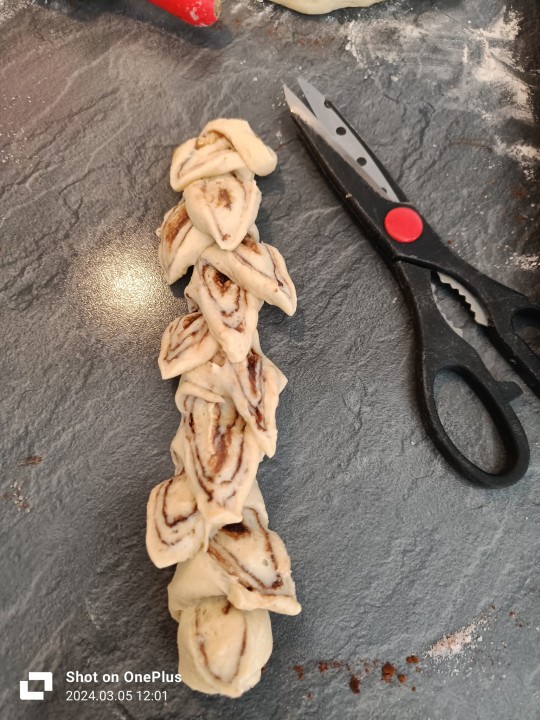


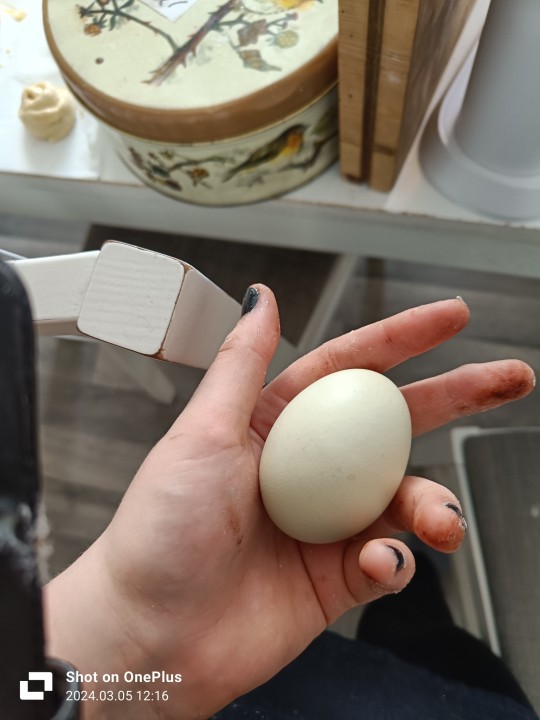

Some pretty baking pics.

My bored doggo
5 notes
·
View notes
Text

Quanto tempo era che non facevo uno shipping meme? (Un po'.) Pensavo fossero ormai una cosa vintage, e forse lo sono, ma mi piacciono quindi chissene.
OTP
Credo che solo con Yu-Gi-Oh! e parzialmente con Hetalia io sia andata su alcune coppie più bizzarre, perché di solito finiscono per piacermi le più ovvie/popolari.
Sì, so che state guardando la Radiostatic perché essendoci una freccia risalta di più, ma la mia OTP effettiva di Hazbin Hotel è più in alto.
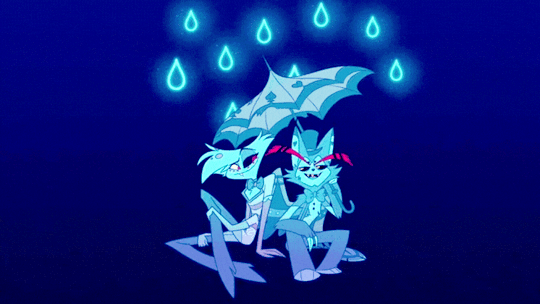
Ché per me Angel e Husk sarebbero andati più che bene anche come amici, ma l'ultimo episodio (E l'account ufficiale di Tw1tt3r, e quello dell'autrice, e quello del doppiatore di Angel, e-) hinta(no) subdolamente altro (Subdoli come le telecamere di Vox), mi si è accesa una lampadina (E l'ho spenta ché costa) e niente è stato più come prima (O qualcosa del genere).
Sono entrambi in situazioni diversamente piacevoli, il loro duetto in italiano si chiama "Fai schifo, baby", sono uno tsundere sessantenne e un angry teenager trentenne, quindi non potevano che essere una zolletta di zucchero ricoperta di miele con gocce di melassa. Consigliato un dentifricio di buona qualità, ma solo per rimandare l'inevitabile visita dal dentista.
È una specie di comfort ship, dato che la dinamica in cui li vedo è quella 100% casta, pura e hurt (offscreen)/(a lot of) comfort. Angel ha bisogno di tempo e di far pace con se stesso, per non rischiare di buttarsi su Husk solo per scappare o per dipendenza emotiva, e mi fa piacere che la maggior parte del fandom l'abbia capito.
Bonus:
Nel delirio iperglicemico, ho realizzato che si tratta di un personaggio considerato bello bellissimo + un furry tsundere. Non salvatemi, sto bene così.
Il più giovane è alto letteralmente il doppio del più grande e ha quattro/sei braccia, quindi qualsiasi interazione deve e dovrà adattarsi di conseguenza. (Angel non potrà stare sul pavimento o sul divano per sempre.)
C'è un gatto-gufo, cioè un gatto al quadrato.
Ho passato mesi dietro alla Spamano, mi inoltro in un altro fandom e mi ritrovo frasi e imprecazioni in italiano perché uno dei due è italiano e l'altro parla italiano. CIOÈ DAI.
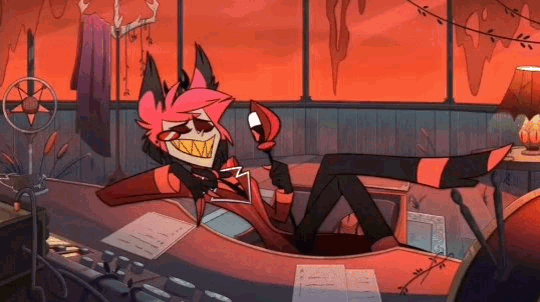
L'altra mia OTP di HH è la Radiostatic, rigorosamente onesided, perché il contrario la renderebbe meno comica.
Io sono certissima, come il 99,9999999% degli spettatori (Anche se c'è da vedere se la seconda serie dirà il contrario), che la proposta di Vox ad Alastor fosse una proposta lavorativa come quella che ha con Valentino, ma Alastor non l'ha capito e pensa che Vox sia solo molto comicamente permaloso.
Sì, devo ancora capire perché Alastor sembri a sua volta un ex inacidito - O forse è solo boomer.
Bonus:
Si sprecano i post di confronto tra tutte le cose che fanno in pendant - A parte il celebre graffiare il tavolo, si arriva al "Ahah, cos'hai detto?", passando per i cosplay in coordinato (Lo sapevo che il pastorexsuora avrebbe fatto danni!) e pezzi di coreografia simili. E hanno pure il design complementare.
"Ti ha quasi sconfitto" implica che Vox ha vinto. Alastor ha perso contro Vox. Dopo che ha rifiutato la sua "proposta". La Radiostatic è un generatore universale di cazzate perché non è solo Vox ad essere il disagio.
La foto. Alastor si è fatto fotografare con Vox. Vox ha strappato la foto e si è tenuto la metà con Alastor. Spero vivamente l'altra metà non ce l'abbia Alastor. Si necessita backstory per maggiori bonus di disagio completo.
Può sembrare che shippare Radiostatic onesided equivalga a bullare Vox. In realtà, gli si sta solo dando corda.
Sto shippando un cervo con un televisore.
Mi piacciono

La Chaggie ha tutte le qualità per entrare nel cerchio OTP, ma le manca ancora una piccolissima spinta che non so neanch'io cosa dovrebbe essere.
"Chaggie" e "Huskerdust" dovrebbero essere le uniche coppie ad avere solo i nomi dei componenti, e la seconda è pure uno scioglilingua. Se però alla seconda sembra andare bene così, in realtà la prima si chiamerebbe anche "Rainbowmoth". Perché pare che Vaggie fosse associata alle falene (Probabilmente perché lo era la sua versione beta nel fumetto Zoophobia). Ora, con plurimi milioni di specie di esseri viventi sul pianeta, con tutte le parole del vocabolario inglese, si è veramente andati a prendere l'unica specie animale che in HH è associata al Male Cosmico Ché RadiceDiOgniMale Levete? Allo stesso tempo, non le si può neanche associare la parola "angel", perché c'è un altro personaggio che si chiama così! /SaveVaggieShipNames2k24
Insomma, Charlie e Vaggie. Amo il loro rapporto e come viene presentato - Mostrato da dettagli come i nomignoli o il fatto che dormano insieme, il fatto che Vaggie sostenga Charlie sia nelle cose più assurde (Tipo i bellissimi esercizi) che in quelle più serie (Tipo Charlie che deve trovare la forza di chiedere aiuto a suo padre); al tempo stesso, Charlie cerca di darle più spazio possibile e integrarla con il gruppo (Tipo spronarla a decidere come impostare gli esercizi sulla fiducia, che tra l'altro è pure foreshadowing). Ho apprezzato molto com'è stato affrontato il segreto di Vaggie, da entrambe le parti - Per nessuna delle due è stato fonte di priorità discutibili quali incentrare tutto sul drama e dimenticare lo sterminio (Dubitate che altre opere non ne avrebbero approfittato?), Vaggie è sì rimasta in silenzio al Concilio, ma si è anche rifiutata di spalleggiare Adam, e Charlie l'ha perdonata dopo un sentitissimo periodo di dubbi e paure. È sempre un piacere vedere coppie che si comportano da coppie!
Bonus:
È una coppia il cui conflitto si basa sulla trama e non sul romance spicciolo e spesso squallido. Ciò non vieta a Vaggie di fare facce inorridite nel realizzare quanto la Rainbowsmile sarà popolare.
UNA COPPIA LESBO IN CUI ENTRAMBE HANNO I CAPELLI LUNGHI.
Voi non capite, io ho da secoli un dramma in corso con gli yuri per cui le due tipe hanno rigorosamente i capelli lunghi+corti o lunghi+legati (di solito in codine) di modo che sembrino corti. Miku e Luka sono state per tanto tempo un'ancora di salvezza - Per quanto in realtà anche Miku ha i capelli legati, ma almeno rimangono lunghi. Sì, Charlie ha teoricamente i capelli legati, ma sono due nastri lentissimi e il design è in generale quello di una ragazza con i capelli lunghi.
La ragazza più arcobaleni e gioia e buoni sentimenti è una stangona in pantaloni e la tsundere armata è una nana con la minigonna e i fiocchetti. Di solito non mi fanno impazzire le coppie lesbo pantaloni+gonna, ma qui è tutto così a contrasto che fa il giro e diventa bellissima.

La Radiorose funziona benissimo sia come coppia platonica che come coppia di amyketteh pettegole cinquantenni.
Trovo ammirevole come sia bastato un unico episodio per far amare Rosie, farla eleggere zia/madre adottiva di Charlie e convincere una buona fetta di pubblico (Me compresa) che sia la persona con cui Alastor ha maggiore chimica - Positiva. Vox e Luciano sono casi a parte, soprattutto Vox, con cui ha la chimica del clorato di potassio e alluminio in polvere. Soprattutto, è al momento l'unica che può redarguire Alastor e lo fa.
Pare che, nelle primissime versioni, la partner di Alastor fosse Mimzy. Sono cambiate un sacco di cose, quindi nessuno di loro è la versione originale, ma per me Alastor sta molto meglio con Rosie che con Mimzy.
È stato detto che dovrebbero avere un duetto tutto per loro, quindi vediamo se rimarranno "zio e zia", "vecchie comari", "coppia di Evil Overlord&Overlady" o "Alastor, sciocchino, smettila di provare a fare l'antagonista, il tuo destino è nel Team BuoniH".

La Cherrisnake è così assurda che ha un sacco di potenziale.
A parte la gag del "E perché dovrei?", che non so come riesca a far ridere ogni singola volta, è oggettivamente una "disadattato socially awkward pseudogentiluomo di fine Ottocento" + "trucidona selvaggia che parla come la Vecchia Romana" che sembra pure stare funzionando.
Per quanto sarebbe carino se potessero stare insieme, mi accodo a chi spera che, nel caso, Cherri si redima per qualcosa di diverso dal "voglio stare col my luv <3<3<3".

La Staticmoth è la diretta conseguenza dell'essere caduta nella tana del Bianconiglio, averci trovato le V e aver deciso di mangiare tutta la scatola di Eat me.
All'inizio pensavo fossero una poli, o che quantomeno Vox stesse sia con Valentino che con Velvette - E invece pare che Velvette sia tipo l'amykettah/figlia/animale domestico/unica detentrice di un neurone e custode del neurone condiviso che presta solo a Vox.
La Staticmoth è un'altra fonte di delirio comico, però implica due antagonisti (Cioè, uno che ci ha provato e, per il momento, è stato il maggiore aiutante del Team BuoniH, e l'altro che se il principale obiettivo degli spettatori non è scoprire cosa stia facendo Lilith o quale sia il patto di Alastor ma fare puntate su come morirà male c'è un motivo), quindi di solito sembra di vedere le disavventure del Team Rocket.
Al di là delle infinite vignette idiote, hanno una dinamica curiosa: in teoria stanno insieme, ma sono ossessionati da qualcuno che non li vuole. E se da una parte c'è Valentino che fomenta le esplosioni di Vox, dall'altra c'è Vox che sembra rodersi di gelosia - Per motivi sconosciuti e inspiegabili all'intera umana stirpe, dato che Valentino gli dà volentieri ciò che vuole e non credo nessuno voglia essere al posto di Angel. D'altra parte, Vox è l'unico che può placare Valentino senza diventare uno shanghai più o meno antropomorfo, e al momento non si sa perché Valentino gli dia retta (A parte per la sua affascinante luce blu).
La seconda serie dovrebbe parlare abbastanza anche delle V quindi, a parte scoprire l'origine del fallimento Radiostatic, spero si scopra qualcosa in più anche del perché, tipo, le V funzionino, la Staticmoth esiste e cosa c'entri Velvette in questo delirio.
Bonus più importante di tutti i bonus di questo post:
È una falena con un televisore.
Penso vadano bene (No romance)
Come da titolo, miscellanea di rapporti d'amicizia/inimicizia di cui mi piacerebbe vedere di più.

Può sembrare strano, ma non shippo Radioapple. Vorrei vedere di più di loro, in rivalità o scontro effettivo - Perché è quasi ovvio che Alastor ci rivede suo padre, quindi chissà che prima o poi la cosa non esca fuori con legittimo dafaq? di Luciano. (Sì, Lucifero è Luciano, come già Verlaine era Paolino, Akutagawa è stato a lungo Vanessa, Judar era Giuditta e Malik era Merry. Stavolta però è colpa di Tayr.)
Andranno mai d'accordo? Luciano s'informerà mai su chi sia il demone della radio? Alastor la smetterà di intrufolarsi nelle canzoni altrui per farsi notare? Qualcosa mi dice che tutte e tre le risposte siano "no", e va benissimo così.
Bonus:
Tumblr smettila di spammarmi Radioapple.

Ricordavo che Cherri avesse un gran screentime nel Pilot, ma Addict l'avevo vista una sola volta. A rivederla, è praticamente un OAV su Angel e Cherri.
In soli cinque minuti butta lì un sacco di cose interessanti - Cherri, con tutta la poca grazia e i suoi traumi? anche lei con relazioni abusive??, come unico conforto di Angel, entrambi messi malissimo che si sostengono a vicenda con uno stile di vita molto poco sano, ma che è l'unico modo che conoscono per stare meglio.
Nella serie Cherri avrà tipo venti battute, ma mi è piaciuto molto come, nonostante consideri l'hotel un'idiozia e pensi che ubriacarsi/dr0garsi sia bello e Angel scemo per volervi rinunciare, rispetti le sue scelte e rimanga con lui persino alla battaglia finale. Cherri è l'incarnazione della "cattiva compagnia", eppure risulta una vera amica. Sono sicura che dovesse avere più screentime, chissà che non rimedi nella prossima serie!
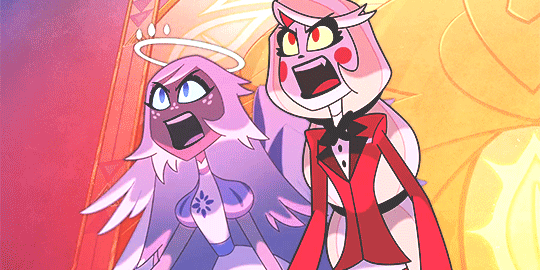
La Rainbowsmile è piuttosto popolare, ma io le preferisco come amiche.
Probabilmente Emily avrebbe dovuto avere più screentime ma, in realtà, mi piace molto com'è risultato il loro rapporto: Emily e Charlie sono molto simili, è quasi sicuro avrebbero fatto amicizia a prescindere, ma il precipitare degli eventi ha portato i loro punti amicizia da 10 a 70 nel giro di una canzone - Il tutto perché entrambe mosse da un forte senso di giustizia, e hanno sentito nell'altra qualcuno di molto affine.
Nella quasi totalità dei casi i rapporti così sembrano e spesso sono rushati, ma qui è fatto talmente bene che mi piacciono e vorrei vedere più di loro - Magari in momenti meno pregni di trama e drama.

Infine, Alastor e Niffty.
Non credo necessitino di paragrafi esplicativi, sono bellissimi e basta.
Vorrei sapere come Niffty sia finita al servizio di Alastor - O meglio, perché Alastor abbia preso in servizio Niffty.
Chissà che non sia vera la teoria della "casalinga lobotomizzata con marito abusivo" e Alastor che ci ha rivisto sua madre. Sarebbe un'inaspettata svolta drammatica, ma non mi dispiacerebbe. Forse ci rimarrei un po' così, al contrario, se si scoprisse che lei è solo "CAOS GREMLIN LOL" e lui ha pensato fosse divertente-
Altre relazioni che mi incuriosiscono ma che non ho incluso nell'immagine, in ordine sparso, sono anche Alastor e Mimzy, Husk e Cherri, Luciano e Adam, Husk e Alastor, Emily e Ser Pentious, Luciano/Adam/Lilith/Eva.
Non mi piacciono
Nessuna! Ci sono coppie che non m'interessano, ma nessuna che non piaccia-
lol nope

Perché la Mothdust ha un colore tutto suo, che ho aggiunto apposta per loro!
(Pensavate mettessi una gif esplicitamente Mothdust? lol nope.)
Okay, in realtà, a livello di storia, mi piace un sacco e vorrei che venisse sviscerata malissimo, a partire da com'è nata e perché Angel abbia firmato un contratto demenziale che implica nello studio dimmi che ti piace baby sono tuo fa ciò che più ti vaaaaAAAAAAHHHH - Soprattutto perché le firme sono tutte svolazzi e cuoricini, quindi sembra fosse più che d'accordo. Angel era un povero ragnetto ingenuo? Valentino era stronzo fin dall'inizio o si è incattivito? In realtà all'inizio erano norm- ahah, okay, no, non si spiegherebbe il contratto (A parte l'aver letto 50 sfumature di grigio e aver preso il bad end). Ma, soprattutto, Angel si ricorderà mai del corretto ordine della catena alimentare tra ragni e falene? Nel mentre, mi accodo a chi spera in uno sbagliatissimo duetto tra loro due.
Per quanto ami la Huskerdust Overlord!AU che circola da un po' e certi cliché mi piacciono tanto, non sono sicura di come nel caso prenderei Husk che, nel canon, vince il contratto di Angel. Non per questioni di "damsel in distress", ma perché preferirei fosse Angel a fanculizzare definitivamente Valentino. Se poi Husk insegna ad Angel come barare giocare a poker, Angel si riprende il suo contratto e incastra Valentino in una gigantesca ragnatela a cui poi dà accidentalmente fuoco come ben insegna Charlie, chi sono io per oppormi?
Grande esclusa?

Luciano e Lilith. So che piacciono un sacco e ci sono tante fanart carinissime, ma non ho idea di come siano e come stiano, quindi per ora il giudizio è sospeso-
4 notes
·
View notes
Text
All right, it seems like I’ve got a lot of understanding and rational people who responded to my earlier inquiry about making a Claire criticism post. So I’m gonna go ahead and do it, since this is something that’s sat in my mind every time a new installment of the ToA series came out.
SO BIG DISCLAIMER BECAUSE I WANT EVERYONE TO READ THIS BEFORE ANYONE GETS MAD AT ME:
THIS IS ALL MY SUBJECTIVE OPINION. I MIGHT BE PHRASING THIS POST LIKE IT’S AN ABSOLUTE, BUT IT’S NOT, IT’S ALL ISSUES I PERSONALLY FEEL WITH CLAIRE’S CHARACTER. SO IF YOU LIKE CLAIRE, THIS IS NOT A PERSONAL ATTACK OR ME TELLING YOU YOU’RE WRONG ABOUT SOMETHING/CAN’T LIKE CLAIRE.
Now that I think I’ve got that out of the way, I wanna jump into the actual post of why I’ve never really liked Claire’s character.
If we’re being really really REALLY honest... I think the issue is mostly based off of “The writers didn’t know how to write Claire”. I’ve felt like every character in Trollhunters (specifically Trollhunters, we don’t talk about 3Below and while Wizards was pretty positive overall, that was also a lot of hit or miss, and that series plays even more into why I don’t like Claire) was executed pretty well to fulfill their roles as characters or to be compelling and pretty easy to grasp their personalities.
Except Claire.
Personality issues:
Her character’s inconsistent and flip-flops. To start off, her intro in the series is just “pretty girl that Jim likes”. We get the promising sense that she has some non-conforming interests at first, as she’s advertising try-outs for the play, but that’s just lifted from the Trollhunters book and we never see any interest in theater arts from Claire ever again after that. Her hair (and I’m sorry but I hate her hair with all the stupid hairclips in the front, it’s so distracting and it looks dumb) with the streak in it and the skull shirt she wears makes you assume she’s somewhat rebellious, maybe kind of punk, but she’s a straight-A trouble-free student who’s apparently popular with everyone, and helps her mom out with campaigning for her political career. There’s really nothing to her personality that shows itself consistently, besides the Papa Skull interest.
And then there’s how badly her character and personality was executed at first; When Steve’s about to beat up Jim, she tries to step in but gets shoved back. Great! She has a sense of right and wrong and she’ll stand up for others. But then later on, she scolds Jim for the crime of... standing up for himself? Which sends a really bad message that she’d have rather had Jim publicly humiliate himself and/or possibly get beat up. Then later she’s willing to go to a Papa Skull concert with the same guy who shoved her. That’s incredibly weak character right there.
She starts to show some more positive character when after getting mad at Jim for trashing the house, she puts two and two together and realizes something’s off, but then she just... sneaks into his house like a weirdo, even though nothing about her character suggests that she’d do something like that and she has no real reason besides “Jim wasn’t straightforward about the party”; it’s not something a normal person would do or what SHE would do given her current character development. And then this one’s a smaller gripe, but I hated her scoff in Wizards when the tournament was going on and the guards didn’t let her in, she goes “Ugh, boys’ club!”. UH HELLO, YOU IDIOT. THERE WERE FEMALE GUARDS CLEARLY EMPLOYED IN ARTHUR’S SERVICE. HELL, THE GUARD THAT BULLAR ATE WAS A FEMALE GUARD. GET OFF YOUR HIGH HORSE AND STOP PRETENDING LIKE YOU’RE BEING SLIGHTED BECAUSE YOU’RE A GIRL. YOU WERE CONSIDERED A CIVILIAN TRYING TO ENTER A TOURNAMENT FOR TRAINED KNIGHTS.
Now past all the character inconsistencies in those first thirteen-ish episodes, the second issue I have with Claire’s character is that she teeters pretty dangerously into Mary Sue territory. Everyone (I was almost gonna say “who isn’t a major villain” but EVEN MORGANA ends up liking her. So MOSTLY everyone) who isn’t a main antagonist ends up liking Claire in some way. Steve the bully? Tries to date her. Mary, whom she said she wasn’t really close friends with? Is friends with her and even has her number. Freaking VENDEL, the grumpiest character in the show, only has to hear her talk in Troll and he immediately likes her without her having to earn his trust (which also she just... never uses Troll again. Sure is convenient that she learned to speak fluent Troll just for one scene and one character to like her). Morgana takes a liking to her. Compare that to how hard Jim had to work to gain the trust of others: His bond with Draal, learning to prove himself to Vendel, engaging with Nomura in prison and befriending her. She too easily assimilates with other characters; I’d have less issues if she had to work like Jim did, but the only time she does is with NotEnrique.
Skills and abilities don’t feel earned or consistent:
And then the whole thing with her powers and her physical abilities. It was never explained in the show how she actually obtained innate magic powers not connected to the Shadow Staff itself (And no, if you have to explain it on Twitter as a writer, that’s not good writing, that’s forcing your audience to play detective). She’s just all of a sudden doing awfully-convenient high-level magic in the first two episodes (or maybe three, whenever she created that shadow-cover for Jim and the others to escape.) without explaining HOW she had got those powers, and then she performs it perfectly whenever the plot needs it (She’s literally shown to be more powerful than Merlin, how stupid is that?). Remember in the movie where everyone was like “Oh no Claire, don’t use your powers because it could hurt you!” and she does anyways and she faints for like three seconds and then has no other physical repercussions? Or how she’s somehow MORE capable than Jim when it comes to fighting, like how in the Chinese Trollmarket she manages to swipe one of the other troll’s weapons, which has an entirely different weight and size to her shadow staff and probably required extensive training, and she just uses it flawlessly to fight? The only times Claire really fails are when the plot calls for it.
Plot can’t happen without her:
And finally, she hijacks the plot constantly, more than her character should, and has more importance placed on her role in the story than anyone else. Even Blinky. She even took over the plot for Wizards, which was supposed to be Douxie’s story and Douxie’s character-focus. The poor guy took a backseat to his own story because the plot relied on Claire to move forward, literally nothing could be done without her. And I mentioned it before but even though Douxie’s character still managed to get enough development, it was hardly enough because Claire hogged up so much screen-time focusing on HER and HER magic development and HER relationship with Morgana over Douxie and HIS magic development and HIS relationship with Merlin.
And also the fact that it’s Claire who ends up either saving the day or taking priority over the others. Who was the one who defeated Morgana in Trollhunters? Claire. Who brought Jim back to life as a human, despite the fact that even Merlin stated it was impossible for him to make Jim a human again? Claire. Who was it that Jim made sure to establish his relationship with, but not anyone else? CLAIRE. That ending in the movie where he doesn’t seem to care about his relationship with Blinky, Draal, Strickler, etc, but oh we’ve GOTTA have his girlfriend!
Overall, even typing this, I don’t think it’s her fault even though I hate her character; it’s the writers’ fault for doing such a sloppy and inconsistent job because she’s boiled down to just a “girl empowerment”. Because in the book, Claire Fontaine is AWESOME. She’s a Scot descended from a warrior lineage which actually explains why she has weapon capabilities, she’s explained that she’s not really a “popular girl” but she’s super confident in herself and doesn’t really care what others think, and that’s what Jim finds charming about her, and she rips Steve a new one after hearing that he’s just trying to charm her to piss off Jim.
But Claire Nunez is a mess of a poorly executed character. And again, I blame the writers because I think Claire could have been great if they knew what they were doing with her and made her balanced.
#Trollhunters#Tales of Arcadia#Claire Nunez Criticism#Anti Claire#I feel like the whole issue with Claire was that the writers wanted to make their 'strong woman' character but executed it in the worst way#Because Claire isn't consistent and she sure as hell isn't balanced#It's funny; You know who I feel like was the actually strong female character in the show?#Well besides Nomura because I personally adore her but#The strongest female character in Trollhunters is Barbara#Her character actually blends well and it's easy to grasp; She's a naturally kind and nurturing person with a tendency to help others#So she's a doctor; and she's hard-working and does her best as a single mom#But that being said she's still very strong-willed and doesn't just step back; she's a rule enforcer and when Jim's sneaking out#She lays down the law#And it's even pretty clear that she wanted nothing to do with Strickler after she realized he was only using her (at first) to get to Jim#If you ask me I think Barbara was the true female empowerment of Trollhunters. Not Claire. Not Aja. Barbara#But yeah I've been sitting on this for like... five or six years now so it feels good to get this criticism off my chest
65 notes
·
View notes
Text
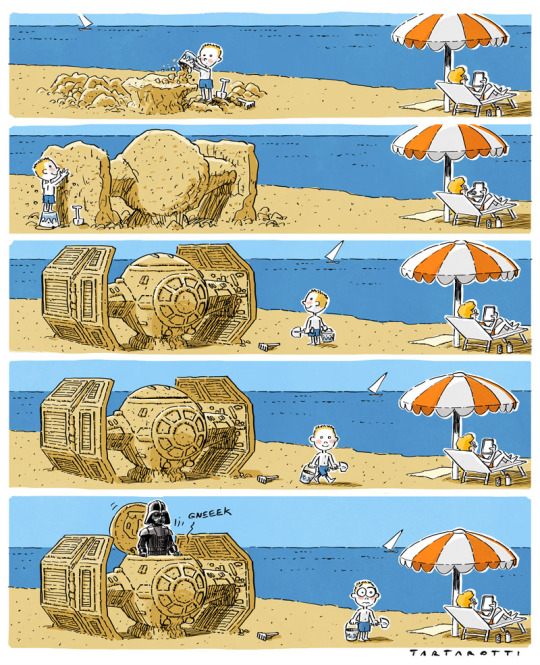
Insomma, mi voglio bullare di una cosa. Lo scorso anno per il 4 maggio (May the Fourth be with you) Stefano Tartarotti ( @tartaro7 ), ottimo fumettista, postò questa vignetta.
Io la ritwittai taggando Mark Hamill.
Mark Hamill rispose con un like.
Quasi quasi lo metto nel curriculum.

3 notes
·
View notes
Text
Checkout the Premium Bullar Boxing Gloves at Affordable Prices
There are hundreds of brands but Bullar Fitness Offers the premium boxing gloves for training/match at an affordable prices. Shop this product & get discounts also
0 notes
Text
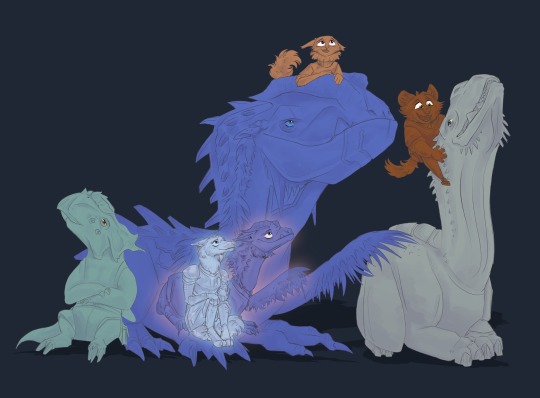
Troll hunters AU, where everyone is anthropomorphised. Humans are demestic animals called demestics, but are known by the magical world as fur times instead of flesh bags, trolls are preastoric creatures, like dinosaurs. They are known as fossils and the sunlight rule still applies, but they turn into fossilised skeletons rather than stone.
Blinky is a pachirinosaur, Aaarrrgghh an argentinasaurous, Toby an African wild dog, Claire a Maincoon and Jim an Alaskan Malamute. Fossil Jim is half malamute half Dilophosaurous half breed, and his beast form a more powerful version of his Dilo half.
Story is relatively the same up untill Wizards, where Claire becomes hit instead of Jim but Jim is able to share her pain using the absorption magic he gained from being a hibrid, Clare is freed from the curuption and gains a better understanding of herself and her fears, but as a consequence looses the inocence she once had due to the things she did within the time having the shard. Jim shearing the pain causes a defence mechanism in his own body causing him to turn into the beast. Jim is also more feared by the demestics of Camelot and confusion from the fossils of Deoza, as he is what’s classified as a sharp tooth, a carnivorous focal with a natural instinct to kill. Jim does not have that desire due to his demestic side but they fear him anyways as Gunmar, Bullar and most of Gunmars fleet are also sharp tooth, this is what causes Arther to sentence him to death. The amulet gets destroyed but not in the same way as befor. In order to stop the green night both her and Douxie are forced to destroy it with there own magic. Also because I thought it would be ironic Arther ends up being eaten by rage mode beast Jim as a consequence of calling other fossils beasts for so many years. Jim does not realise this until after Claire wakes him out of it. They end up comming out of it with more scars, no amulet, powered up Claire and a permanently beast Dilo Jim. But they work through it.
#trollhunters#anthropomorphic au#wizards tales of arcadia#trollhunters toby#jim lake jr#troll jim#claire nuñez#blinky#aaarrrgghh#trollhunters au#heartstorm
28 notes
·
View notes
Text
Drakonidae

Here are all the drakonid dragons for my Dracones Mundi project! Of all the dragons these have the most basic dragon bauplan: four legs, sometimes wings (wings for both males and females in firedrakes, for just the males in the azi and long), and a long body shape with a flexible armour of overlapping osteoderms. This is just one of eight dragon families in the project (the others being armoured dragons, beast dragons, wyverns/flying serpents, birdlike dragons, wyrms/serpents, sea serpents and feathered serpents).
The drakonids are split into three groups: the firedrakes, the azi and the long.
Firedrakes
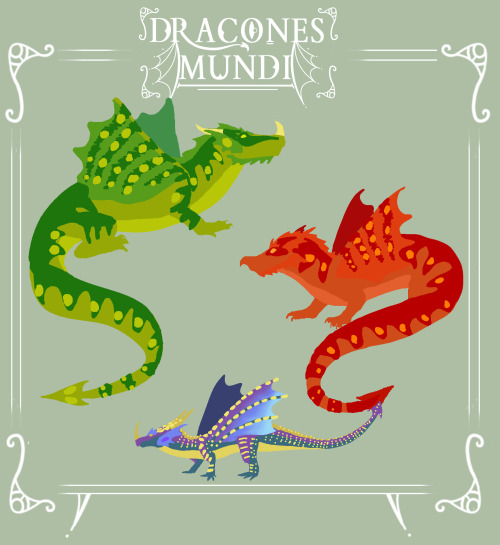
The Viridian Firedrake (subspecies - Chudo-zmeya, Belarussian Smok, Bullar/Bolla/Balaur, Hala and Hydra. Found throughout Europe)
The Common Firedrake (subspecies - Western Firedrake, Welsh Ddraig Goch, Polish Smok. Found throughout Europe)
The Glitterdrake (subspecies - Emerald glitterdrake, sapphire glitterdrake, ruby glitterdrake, gold glitterdrake, amber glitterdrake, purple glitterdrake, rose glitterdrake, dark dragon, pocket dragon, moon dragon, sea dragon. Found throughout Macaronesia)
Long
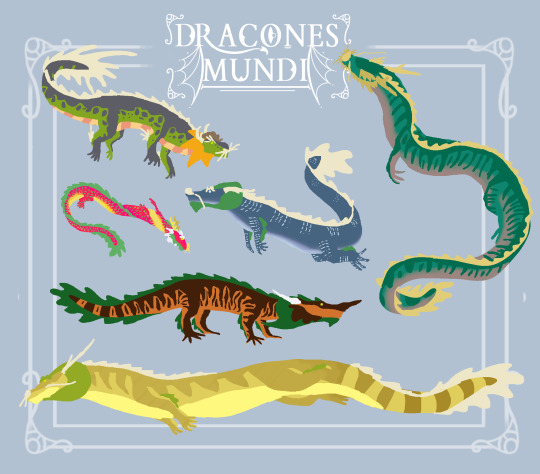
Druk (subspecies - common druk/Bhutanese druk, jade druk, Himalayan druk, Tibetan druk, Nepalese druk, bailong. Found in Bhutan and throughout the Himalayas)
Azure dragon (subspecies - qinglong and yong. Found in China and North and South Korea)
Ryu (subspecies - Honshu, Hokaido and Ryokoko. Found throughout Japan)
Dancing Naga (subspecies - pink vs a more firey orange maybe? Found throughout East and Southeast Asia)
Rong (found in Vietnam)
Yellow dragon (found in China and North and South Korea)
Azi

Nahang (found in central Asia)
Azhdar (found in West Asia, especially Iran)
Vishap (subspecies - Armenian vishap and Georgian Gvelashapi)
#Dracones Mundi#Dragon#Dragons#12 dragons down 30 to go hehe#This is still subject to change as I keep writing but I thought everyone would like to see a collection of the dragons together#Firedrake#Firedrakes#Long#Azi#Azhdar#Vishap#Nahang#Druk#Dancing Naga#Glitterdrake#Glitterdrakes#Ryu#Rong#Yong#Qinglong#Zmey
63 notes
·
View notes
Text
Kulshedra
The kulshedra or kuçedra is a water, storm, fire and chthonic demon in Albanian mythology and folklore, usually described as a huge multi-headed female serpentine dragon. The kulshedra is believed to spit fire, cause drought, storms, flooding, earthquakes and other natural disasters against mankind. In Albanian mythology she is usually fought and defeated by a drangue, a semi-human winged divine hero and protector of mankind. Heavy thunderstorms are thought to be the result of their battles.
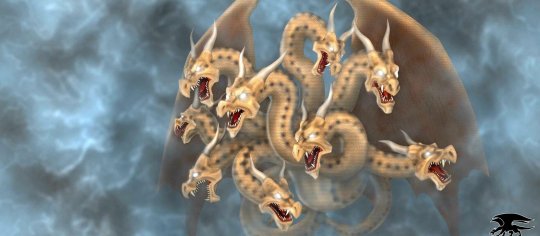
Pic by Adrian Veenje
In northern beliefs, the kulshedra can take possession of the sun and moon. In southern beliefs, she is described as an enormous female serpent who surrounds the world. According to this version, if she were ever to touch her tail with her mouth, she could destroy the whole world. It is said that she requires human sacrifices for accepting to postpone the natural disasters and catastrophes.
According to folk beliefs, the kulshedra's earlier stage is the bolla, which has the appearance of a water and chthonic demonic serpent. The bolla's eyes remain shut for the whole year except on Saint George's Day, when it gazes the world and will devour any human on sight. The bolla will eventually morph into kulshedra if it lives many years without being seen by a human. The bollar and errshaja are considered intermediate forms of this serpent as it goes through a series of metamorphoses. These terms also signify serpents; the term bullar merely being a synonym for bolla in Southern Albania. In some regions the kulshedra is depicted like a female eel, turtle, frog, lizard or salamander.
The kulshedra can also appear in the guise of a woman, who keeps her true nature hidden. As a semi-human divine figure she holds also positive qualities that emerge indirectly from Albanian folk tales, beliefs and rituals. It is said that the village where the kulshedra lives has great prosperity in agriculture and livestock. Indeed she absorbs by her breath foodstuffs from everywhere, and her village thrives, while the affected villages become poor and do not prosper. According to folk beliefs people used to practice sacrifices to her so she could bring them good and stop any harmful action.
The term bolla is etymologically related to Greek Φάλη, Φάλαινα 'monster, whale' (although the relationship is not certain).
Kulshedra or kuçedër derives from the Latin chersydrus, roughly meaning an "amphibious snake".
The term bullar is given as a Southern Albanian variant by some sources.
The legendary battle of a heroic deity associated with thunder and weather, like drangue, who fights and slays a huge multi-headed serpent associated with water and storms, like kulshedra, has been preserved from a common motif of Indo-European mythology. Similar characters with different names but same motifs representing the dichotomy of "good and evil" – mainly reflected by the protection of the community from storms – are found also in the folklore of other Balkan peoples.
The bolla is said to remain closed-eyed until Saint George's Day, where it peers into the world, and will devour any human that approaches it. It is explained in folklore that Saint George had cursed the beast to be forever blind except on his feast day.
Kulshedra is generally considered to be a female dragon, like a multi-headed serpent form, but it is known to have pendulous drooping breasts touching the ground, thus some German commentators have stated she might be also regarded as a hag. Kulshedra is furthermore said to be covered in wooly red hair, have a long tail, and have seven to twelve heads. It is also said to spit fire. Kulshedra's milk and urine are both considered poisonous. Kulshedra can also appear in the guise of a human female; its appearance in an ordinary woman's guise known locally for example in Dukagjini, Kosovo. It may also appear in the form of a female lizard, turtle, frog, or salamander.
At the same time, kulshedra is widely considered to be a storm demon. Kulshedra is believed to cause drought and other water-related issues for humanity such as torrents, tempests, water shortages, big storms, flooding, or other natural disasters. Often to placate it, a human sacrifice must be made, as witnessed in the tale of the hero Qerosi ("Scurfhead").
In southern beliefs, she is described as an enormous female serpent who surrounds the world. According to this version, if she were ever to touch her tail with her mouth, she could destroy the whole world. In northern beliefs, the kulshedra can take possession of the sun and moon. To frighten the evil demon, the Albanian tribesmen used to shoot in the sky or provoke great noise with metal objects, even by ringing the church bells.
"The male form, called Kulshedër, acts as a devil".
According to folk belief, a snake after living a certain number of years will metamorphosize into a bolla and eventually become the monstrous kulshedra. The belief that an ancient snake becomes a dragon is not unique to Albanian culture, and similar beliefs can be found for example in Hungary and Romania, as pointed out by Robert Elsie.
In the Kosova town of Prishtina, the kulshedra begins life as a being invisible to mankind for the first twelve years of its life, after which it turns into a bolla ("a kind of serpent"), and afterwards it sprouts wings, becomes hairy, and begins to combat the drangue (dragúa). But the folklore of Malësia and the Northern Mountain Range in Albania provides a more complex life cycle: when the serpent manages to live fifty years without being noticed by anyone, it becomes a bullar, a reptile that feeds milk to snakes, from which these snake derive their venom. If it lives another fifty years without being seen, it becomes an ershaj which coils around its human victim's neck, punctures his chest and eats the heart. When an ershaj (er̄šaj) lives for another century unseen, it finally becomes a kulshedra.
In Tirana, kulshedra was said to begin life as a being hiding in a dark hole which became a snake after six months; the snake must grow an additional six months before it exhibited the behavior for which it could be properly called a kulshedra. Among the Albanian Kastrati tribe, it was believed that a snake sighted by a wren lost its ability to transform into a kulshedra.
Dragùa, sometimes called drangue or drangoni, is the male conqueror of the female monster kulshedra, whom he must fight to the death in collective beliefs. Their prime aim in life is to combat and slay Kulshedras. They thus spend much of their youth exercising and running around, so as to learn how to avoid kulshedra's urine and milk. When they sense a Kulshedra approaching, dragùas "go completely berserk and their souls depart from their bodies in preparation for the coming battle". When a human is attacked the dragùa will "fly to their assistance and slay kulshedra by pelting it with cudgels, ploughs, yokes, lances and stones, and even with uprooted trees and houses. Such attacks are seen by humans as lightning". Heavy thunderstorms are thought to be the result of the battle.
The dragùas, even as infants, use the cradle to shield themselves from kulshedra's attacks, which consist of her urine and poisonous milk from her breasts. They also use this cradle as weapons.
In the Northern Albania, the two are envisioned as battling perpetually in the bend of the Drani River in the Northern Mountain Range. But some folklore speaks of the dragùa accomplishing kulshedra's destruction by drowning, and in Central Albania, the hero is said to have drowned her, knocking her unconscious by throwing trees and boulders at her, and afterwards drowning her in Shkumbin, a river in central Albania.
Dragùas are not the only beings said to have defeated Kulshedra. There are multiple folktales in which saints and folktale heroes not identified as dragùa have defeated Kulshedra.
Saint George and Saint Elias (originally the Old Testament prophet Elijah) both have stories in which they fight (and defeat) a Bolla/Kulshedra. Saint Elias, in particular, is identified in some regions with the Dragùa and is also a weather god and provides protection against storms and fire.
7 notes
·
View notes
Text
Bular’s Day Out
I had this idea for a fic, I would propably never write, shame, I love it, so I can at least share the concept...I mean, why waste it, good AU concept is fun to read too
Because I am a sucker for redemtion arcs (well writen not just thrown on us like we were stupid) I was thinking of HOW I would do red.arc. for Bullar? I came up with what comes:
It is post ROTT timeline where Jim is a trollhunter. He is trying to make things right but the timeline goes WILD very qickly. Mainly because Stricler noticed that his enemies, seem to know things they shouldn't and gets far more caucious. I feel like Stricler would be far more dangerous villian if he just took Jim more seriously.
Somehow, Bular gets affected by that "human potion" from Gattos trasure. For the purpose of the story I am assuming it was not an accidental mix of potions, but really just one of them that will work the same no matter if it is thrown into the lava or just spilled on someone.
So Bular the Bucher is a temporarily human and super unhappy about that. He also don't know what is happenineg but he knows that Stricler will take that opportunity to ruin his possition, maybe even convince Gunmar, that his son is a lost case.
Bular is driven by one motivation, gaining and keeping his father's affection forever. And he well knows that Gunmar is loving him only as long as Bular is his perfect subject.
Oh, yeah, Gunmar is a bad father in this version. He is a true psychopat and is rally not capable of loving anyone but himself, and he views Bular as an extension of him, his smaller copy. Every time Bular does something Gunmar wouln't do, he is pissed. o B just learned to copy whatever he thing his father would do, incorporating anything he says as his own, never really developing own ideas.
He is okay, as long as he is strong as he is winning, and now he is not only weak, but a crature most despised by Gumm-Gumms. So, basically he has a problem.
Bular is not accustomed to being a fleshbag and heunderstans them far less than Blinky, so he is not doing very good. He runs from the changeling, untrusting of them (understandably after he terrorised and killed them for so long). And he is captured by Trollhunter,and the don't really know what to do with him.
Akiridions come to earth ealier that in Oryginal Timeline. Maybe because Morando's close encounter with godgood gave him ability to partially remember previous timelines, so he acts differenly? Not shure.
Bular beigns to form relationships with the good guys especially with Varvados, ARRGGHH!!, Krel and Toby in that order. He learns a lot about being a human, but also about being a troll and that life can be more than just fighting, killing and eating. That there is more to honor than wnning, and that for parental love you don't need to deserve.
The concept really extended above my expectations and thats why I don't think I could write it.
There was a whole intrigue around Bular's second parent, and Varvados were supposed to turn from "worthy enemy" to the real "fraher figure" for Bular.
#trollhunters#au concepts#fic concepts#bular#bular the butcher#varvatos vex#gunmar#gunmar the black#bular's day out#my post
22 notes
·
View notes
Note
How do you make your Glögg?
This one was bought at the store, served with allmonds and rasins. 🎄 My mother used to make glögg och mjöd for chrismas when I grew up. But I buy mine or get from friends and family. Have other projects that take time. 😅 Gingerbread house and cookies, lussekatter (bullar), knäck and decorations. 😊

December 2023
Avesta, Dalarna, Sweden
#questions#my stuff#sweden#swedish#my photos#my life#enjoythelittlethings#dalarna#swedish food#food and drink#drinks#swedish cuisine#my post#my kitchen
6 notes
·
View notes